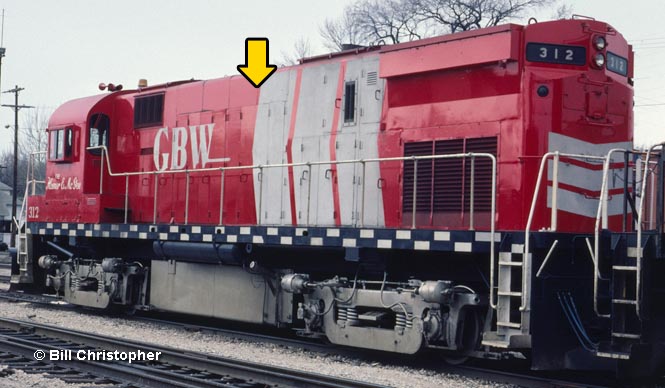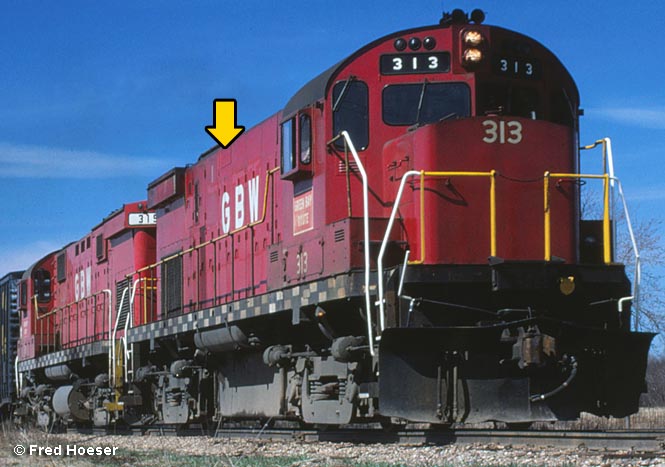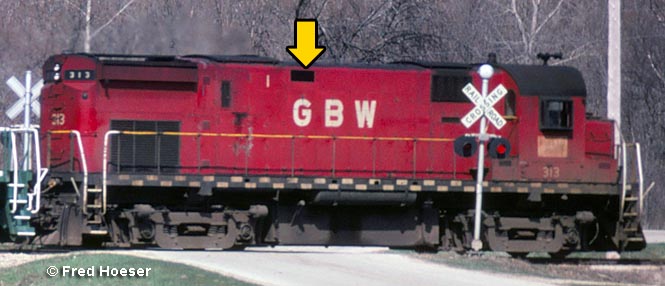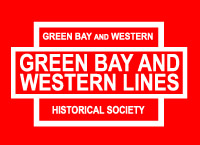GBW Questions & Answers Archive
Questions & Answers is a forum for information about the GBW that seeks to leverage the great wealth of GBW knowledge within the GBWHS. If you have a question about anything pertaining to the Green Bay & Western, send it to editor@gbwhs.com. We will research our archives and ask GBW employees and other GBW experts to find the answer. If we can't find the answer, we will post the question here and in our magazine to reach a wider audience and hopefully find somebody who knows the answer.
1. Vents on 312
Stephen McMillan asked:
If you look at the 312, she does not have any vents along the top of the hood above her engine room doors. On dynamic brake equipped units there are 3 vents, with the forward 2 used to get cooling air to the DB grids. The one to the rear should be on all 4 axle Century units, as that is where the air used to pressurize the engine compartment exited. 315 does not have it, as there is a slot on the roof, covered by a walkway, that performs the same function, just like on the six axle Century units. There is no other Century like 312, and I have never been able to find an answer as to why she was built like that. Any ideas?
Here's a photo of 312 from April 1982 that shows where the vent should be:

Dan Luedke replied:
The 312's vents or lack of them is a little strange. Maybe it had one when it was built and the GBW closed it up. If you look at different photos of the 311 you will see it arrived with them, then they were closed up, and later photos show they were back. I really don't know, but the GBW would do some experimentation sometimes.
I asked (GBW Manager of Locomotives) Mike Geurts about the vents on the 311, 313 and 314 and why there were none on the 312. To make it simple, he doesn't know why there weren't any on the 312. The only reason he can think of why they would close off and then reopen the ones on the 11, 13 and 14 was to keep out the cold air and more importantly any fine snow that would be drawn in through the vent. He said the air compressor was right in that area on the rear of the engine and the compressor had 2 small filters on it, but they found that the fine snow would get through the compressor filters and into the compressor itself and create problems. In the summer they would open the vent to draw in more outside air for cooling and the filters on the compressor would do a good job at keeping out dust and dirt, much better than keeping out moisture from snow. Why the 12 never had any is anyone’s guess.
As evidence, we found this photo of the 313 with the vent plated over in April 1981:

Yet, here's a photo of the 313 with the vent restored in April 1983! Does anybody know the story?

2. Caboose roof color
Jim Blackwell asked:
Being as there are no HO scale GBW cabooses available, I will have to do one up myself and I have acquired the decals to do it. I have looked at many pictures of GBW cabooses but none of the pictures show what color the roofs and roof walks were. I plan to do a bay window caboose that had the yellow paint job so I hope you can tell me what color the roofs and roof walks were on these cabooses.
Dan Luedke replied:
I know the 613 when it was new in the early 60’s had a silver roof, as maybe some of the other ones did when they were new also. They were galvanized roofs so came silver, but as they started to tarnish with age as the cabooses got repainted the roofs and cat walks were yellow. A few years ago when Walthers did the 615, 616 and 617, the models came with yellow roofs. For the most part of their lives the roofs were yellow.
3. Why Alco?
Joel Norman asked:
Why did the GBW go 100% Alco? Fairbanks-Morse was within the state, EMD had a plant closer than Alco, and I’m sure General Electric would have cut prices to the bone to get a sale. I’m not a fan of anything GE; too many years of hearing the Erie-Lackawanna and Conrail engineers saying they should have stuck to light bulbs!
Bill Christopher replied:
I believe the GBW went with Alco for two reasons. First, all the steamers they bought in the 20th Century came from Alco, so they already had a good relationship. Remember that when the GBW started dieselizing in 1938 with the purchase of HH600 101, there wasn’t much information or experience with diesel performance or maintenance, so it wasn’t easy to make a good comparison of one make of diesel versus another.
Second, I think they ruled out EMD because they were owned by General Motors, and the railroad did not want to offend Ford Motor Company, a major GBW customer.
In 1938, FM had not yet started making locomotives, and GE was in a partnership with Alco. Unlike Alco-GE and EMD, Baldwin was still experimenting with the diesel; they were very committed to steam at the time.
Being located close to a locomotive manufacturer offers little if any advantage. The cost of shipping a new locomotive is a very small fraction of the locomotive’s cost over its lifetime.
As the GBW acquired more Alcos, it made sense to stick with Alco, since the railroad was also accumulating parts, special tools and expertise in keeping Alcos running. The Norwood Shops crew was very good at keeping the railroad moving with their all-Alco fleet, so they had very little incentive to change.
I don’t think Alcos were as bad as some folks make them out to be. Alcos were known for good lugging ability, good fuel economy and good performance in extremely cold weather, attributes that were appreciated by the GBW.
Alco’s competitors, EMD and GE, were backed by huge corporations, which helped them in areas such as marketing, product support and parts distribution. As Alco slipped into the number 3 slot, economies of scale started to work against them. Don’t forget they had to buy their electrical gear from one of their competitors. Railroads found that maintaining three or more makes of locomotives created problems with servicing and parts inventory, so they tried to get down to one or two makes. Eventually these pressures forced Alco out of the business.
Considering that the biggest challenge Norwood Shops faced was finding parts, and their newest locomotive (C420 323) was 27 years old in 1993, I think they did a marvelous job of keeping the GBW rolling right up to the end.
Dan Luedke replied:
Stan Mailer and I had several conversations over the years as to why the GBW stuck with Alcos, and Bill’s answers are pretty much what we discovered to be true. If you have time, read Stan’s book, pages 277 through 288. The GBW didn’t just jump into buying Alco diesels; they made inquiries of other roads like the Milwaukee Road and the Gulf, Mobile & Ohio, who already had Alcos. The McGees still had connections to the Katy, who had Alcos as well. Road Foreman of Engines Loyal Van Dreese visited some roads that already had Alcos and investigated them in service, just as Ted Kirkby, a former Milwaukee Road motive power guy, did when the GBW decided to get the 400-class Mikados, which were almost clones of the Milwaukee Road’s L-class 2-8-2s.
It is said that Alco’s S-class switchers were probably some of the toughest switch engines ever built, right up there with the FM H10-44s. Stan told me that during the war years, the government permitted EMD to continue developing their diesel locomotive design, while Alco, FM and Baldwin had to switch their production over to heavy war equipment. So in 1946 EMD had a big jump in advancing their diesel locomotive production, whereas the other three were practically starting from scratch. Trying to catch up probably meant they did not put enough time into developing a better product, thus giving EMD a big edge in sales.
But we know that Alcos that are well cared for, with good people doing the work, will perform above and beyond the call of duty. I witnessed that myself many times.
4. Carferry timetables?
Joel Norman asked:
Did the GBW have a separate carferry employee timetable or employee book dealing with the boats’ operation?
Dan Luedke replied:
No, there were not any special employee handbooks dealing with the carferry operations. However, in the GBW Employee Timetable under Special Instructions, there were a few notes about the carferries. One was that locomotives were not permitted on the carferry aprons and no burning fusees were permitted on the aprons. Also, air brakes had to be in operation while loading and unloading the carferries.
Although not in the timetable, Notice No. N-52 was put out on February 12, 1973 stating, “Before Mechanical Refrigerator cars are placed on the Car Ferries at Kewaunee, it must be known the mechanical unit is shut off. The loaded Mechanical Refrigerators are to be lined up and placed on either of the two wing [outer] tracks of the C&O Car Ferries; unless otherwise directed by someone of authority in charge of the C&O Ferry. L.J. Knutson, General Superintendent.” I also believe this was done on the Ann Arbor carferries, although I think they could be placed anywhere on the boat. When the reefers were pulled off the boat, they were restarted by the train crew or someone from the ferry.
The GBW had nothing to do with the schedule the boats ran on. That was strictly up to the Ann Arbor and C&O. They would call the GBW dispatcher when the boat left Frankfort or Ludington for Kewaunee, which gave the GBW about four hours to call a crew and have a train at Kewaunee to meet it. The C&O usually had a boat at Kewaunee at noon and again at midnight. They seemed to cater more to passengers than the Ann Arbor, which ran an irregular schedule.
5. 2-6-0 Moguls
Joel Norman asked:
How long did the 2-6-0s (like Bachman’s model) last, and who offers decals?
Mark Mathu replied:
Alco built a total of 17 Moguls for the Green Bay Route between 1907 and 1924. The last one (A&W 72) was retired and scrapped in 1953. All the locomotives had a pretty similar appearance, but the railroad had a policy of acquiring equipment one at a time, so they all had subtle differences. And of course, they were modified over the years.
The Bachman 2-6-0 model is based on the GBW’s prototypes, so it is a great match for these locomotives. The headlight on top of the smokebox and bell between the domes match the arrangement on GBW 256 between 1937, the year it was renumbered from 56, to 1939 when it was modernized and the headlight and bell moved to new locations. The major difference between the model and the prototype is the placement of the air pump on the fireman’s side.
The locomotive is available in GBW paint, matching the 1937 and later lettering scheme used by the railroad with the red and white Green Bay Route herald on the tender. DM Custom Decals and John Hagen both offer decals for the pre-1935 lettering scheme with the orange ball-and-bar herald on the tender. Contact them at dmdecals@tm.net or sprinthag@yahoo.com, respectively, for more information.
6. R-T-R Cabooses
Joel Norman asked:
Which ready-to-run caboose fits the GBW?
Mark Mathu replied:
That’s the difficult question. No ready-to-run caboose comes close. The closest I have identified is American Model Builders #867 caboose, but that is a wood caboose, and a stand-in at best. See it here. If anyone has identified a better caboose match, please share it!
7. Norwood Avenue and the Wisconsin Central
John Reger asked:
Did the Wisconsin Central ever use the line along Norwood Avenue to McDonald Yard after they took over the GBW?
Dan Luedke replied:
As soon as the sale went into effect, the GBW Norwood to McDonald's line was considered “off limits” for train operations. The WC had promised the city of Green Bay that they would stop using that piece of track because of all the grade crossings.
On the first day of WC operations (August 28, 1993), GBW switchman Steve Smits and WC engineer Frank Hedstrom and I took old Fox River Valley Railroad (ex-CNW) GP7 4332 down to Norwood from the old CNW north yard, gathered up all the GBW cabooses and about 50 cars out of the Norwood yard, and brought them back up to the north yard by McDonalds. That was the last time I went over that track.
Trains that were still running on the old GBW main line from Green Bay to Black Creek or vice -versa would go through the old Milwaukee Road Oakland Avenue yard, then up to Oneida Street and through the old MILW-GBW transfer track and head west to Black Creek.
That continued until the “new” connection track was built at south Broadway between the ex-CNW Fox River Sub and the old GBW track that went from Norwood down to the GBW Mason Street yard. That connection was opened on November 17, 1995. On that same day the Norwood to McDonald's track along Norwood Avenue was officially closed. It was later removed. There might have been a few switch runs made on that track after I was on it, but no large trains ever ran over it after the WC takeover.
This short piece of track was at one time undoubtedly the busiest on the GBW. With all the over the river switch jobs, Kewaunee jobs and transfer jobs to and from the CNW transfer at McDonald's, there were at times 15 to 20 trains a day. Now, 100 years later, it’s gone. There are now sidewalks and patio decks where the track used to be.
After the “new” connection was opened at south Broadway from the Fox River Sub to the WC Black Creek Sub (the old GBW New London Division), the trains stopped going through the old MILW Oakland Avenue yard. So for awhile there were 120 car coal trains going through Norwood Yard from Black Creek, and regular freight trains used the Green Bay to Black Creek to Neenah line as well. This was mostly done while the WC was rebuilding the old CNW Valley line from Green Bay to Appleton and Neenah. When that was completed the GBW Black Creek line was not used any more and then put up for abandonment.
WC officials referred to trains running on the GBW to Black Creek as “going to the dark side.” There were many, many track changes made in the Green Bay area after the GBW sale. Although the old CNW North Yard and most of the GBW Norwood yard are still here, the old MILW Oakland Avenue yard is completely gone, except for one or two tracks.

